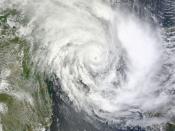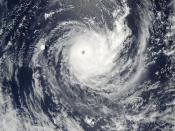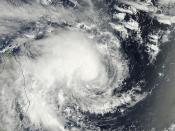Emergency Procedures When Storm Warnings are in Effect
The following warnings will be issued prior to a Hurricane. Members of staff should pay careful
attention to these warnings as there are certain procedures to follow after each warning. Some
radio and television stations in the region have a special signal which precedes warning messages.
Become familiar with them.
Phase A HURRICANE ALERT - Hurricane entering the region.
Phase B HURRICANE WATCH - 36 hours to landfall.
Phase C HURRICANE WARNING - 24 hours to landfall.
Phase D EMERGENCY PHASE - Strike.
Hurricane Effects
Wind damage - This is potentially one of the most destructive aspects of the hurricane. It can result in loss of roofs, windows, doors and vegetation.
Collapse of buildings
Damage by fallen trees - Disruption of electricity and telephone facilities, damage to buildings and blocking of roads.
Flying debris - Zinc sheets, tree limbs, timber, roofing materials, fruits etc.
can cause further damage to other structures.
Rain Damage - Otherwise sturdy trees and light poles may collapse earlier than expected due to water saturation around their bases. Leaking roofs, from torrential downpour can saturate walls and destroy contents of buildings and cause the destruction of structures.
Flood Damage - Disruption of surface communications. For example, roads, flooded or washed away; landslides; bridges destroyed; railway lines flooded or washed away; contamination of drinking water supplies.
Storm Surges - Heavy seas, storm waves and storm surge can cause extensive damage and completely destroy structures and coastal features. The direction of approach of the hurricane and the physical form of the coastal area will influence the potential destructive force of the waves.
Emergency procedures to be followed by personnel in each restaurant
(1)Familiarize yourselves with the plan
(2)Help the rest of the staff to become familiar with the plan
(3)Designate responsibilities for action before, during and after a hurricane
(4)Ensure execution of prevention and preparedness tasks.
(5)Supervise clean-up activities.
(6) Ensure that sufficient quantities of emergency supplies (e.g. batteries, band-aids, stored water, etc.) are in stock.
(7)Dispose of damaged material.
(8)Get first aid training and Administer first-aid when necessary.
All departments should be included when responsibilities are being assigned. These
responsibilities should be made clear to each department and displayed in an openly accessible
place within the department This phase should be ongoing throughout the year. Full preparation
is the key to minimizing loss of life and property, and to ensuring speedy resumption of business.
All Departments have tasks - but leadership is given by the General Manager, during this stage,
attention should be given to:
(1)Vulnerability Assessment, including maintenance and retrofitting requirements
(2)Emergency supplies
(3)Vital records protection
(4)Security protection
(5)Obtaining up-to-date weather information
(6)Training of staff
(7)Insurance Coverage
If you have any questions in regards to this matter please contact your manager and/or have your manager contact my office or myself.
Regards,
Sean Mccaffey, Vice president
References:
Business communication today Unit 4 & 5
http://www.tifton.uga.edu/tiftoncampus/Handbook/emergencyhdbk.htm
http://www.oas.org/en/cdmp/document/chaman/chaman.html
Carrie Childs BUS 210-15


